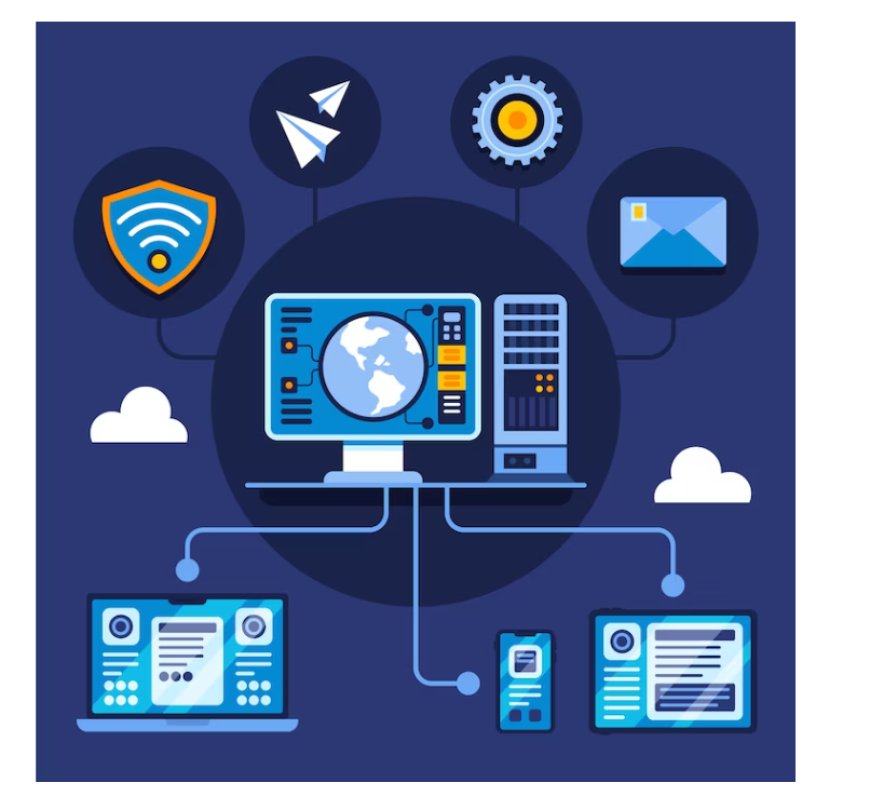Cybersecurity in the Internet of Things (IoT): Protecting the Connected World
Explore the critical importance of cybersecurity in the Internet of Things (IoT) landscape. Learn how to safeguard the connected world from threats and vulnerabilities.

The Internet of Things (IoT) has ushered in an era of unprecedented connectivity, revolutionizing industries and everyday life. From smart homes to industrial automation, IoT devices have become an integral part of our interconnected world. However, this remarkable advancement in technology has also brought forth a new frontier of vulnerabilities. With billions of devices connected to the internet, the need for robust cybersecurity in the IoT ecosystem has never been more critical.
Understanding IoT Security Challenges
The proliferation of connected devices in the Internet of Things (IoT) has brought about a host of security challenges that must be comprehended to protect the integrity of this interconnected ecosystem. These challenges stem from the sheer number and diversity of IoT devices and the vulnerabilities inherent in their design and deployment.
Firstly, the variety of IoT devices presents a substantial challenge. IoT encompasses a wide range of devices, from smart thermostats and wearable health trackers to industrial sensors and autonomous vehicles. Each device type has its unique set of vulnerabilities and use cases. Securing them all requires a nuanced approach that considers the specific security needs of each category.
Furthermore, the scale of deployment is a daunting challenge. IoT devices are often deployed in vast numbers, both in consumer and industrial contexts. This large-scale deployment magnifies the potential consequences of a security breach. A compromised device can serve as a gateway for attackers to infiltrate an entire network, leading to data breaches, service interruptions, or even physical harm.
Additionally, IoT devices are often characterized by their inadequate security features. Many devices are designed with a focus on functionality and cost-efficiency rather than robust security. As a result, they may lack basic security mechanisms such as encryption, strong authentication, or the ability to receive security updates. These vulnerabilities make them attractive targets for malicious actors seeking to exploit these weaknesses.
Common Threats in IoT Security
The Internet of Things (IoT) has opened up a world of possibilities, connecting everyday objects to the Internet and enabling them to collect, process, and transmit data. However, this proliferation of connected devices has also introduced a host of security threats that need careful consideration. Understanding these common threats is essential for devising effective cybersecurity strategies in the IoT ecosystem.
-
Unauthorized Access and Identity Theft
One of the foremost concerns in IoT security is unauthorized access to devices and the theft of identity or sensitive data. Weak or default passwords, a lack of proper authentication mechanisms, and vulnerabilities in device firmware can leave IoT devices susceptible to hackers. Once an attacker gains access, they may manipulate device settings, steal data, or even use the compromised device as a stepping stone to launch attacks on other parts of the network.
-
Data Breaches and Privacy Concerns
IoT devices often handle vast amounts of sensitive data, such as personal information, health data, or proprietary business data. A breach of this data can have severe consequences. Privacy concerns arise when data is collected without user consent or when it is stored inadequately, making it accessible to malicious actors. Data breaches in the IoT can lead to identity theft, financial fraud, and the compromise of individuals' or organizations' sensitive information.
-
DDoS Attacks on IoT Networks
Distributed Denial of Service (DDoS) attacks are a significant threat to IoT networks. In a DDoS attack, a large number of compromised IoT devices can be harnessed to flood a target server or network with traffic, rendering it inaccessible. These attacks can disrupt services, cause financial losses, and impact the availability of critical infrastructure components connected to the IoT.
-
Physical Security Risks
Physical security risks are often overlooked in IoT deployments. IoT devices can be physically tampered with or stolen, leading to security breaches. For instance, surveillance cameras or smart locks can be vulnerable to physical attacks. In some cases, attackers may compromise the physical integrity of the device to gain unauthorized access.
Importance of Cybersecurity in IoT
The importance of cybersecurity in the Internet of Things (IoT) cannot be overstated in today's interconnected world. IoT devices have proliferated across various industries, from smart homes and healthcare to manufacturing and transportation. While these devices offer convenience and efficiency, they also introduce a multitude of security challenges. Understanding and addressing these challenges is crucial for protecting sensitive data, ensuring device integrity, and mitigating potential threats.
First and foremost, IoT devices often handle a wealth of sensitive data. These devices collect and transmit data ranging from personal information to critical operational data. Without robust cybersecurity measures in place, this data is vulnerable to unauthorized access, identity theft, and data breaches. Imagine the consequences of a malicious actor gaining access to a smart home's security cameras or a healthcare device that monitors a patient's vital signs. The potential for harm is significant, highlighting the need for comprehensive security measures.
Beyond data security, ensuring the integrity of IoT devices is paramount. Many IoT devices have physical or environmental implications, such as smart locks, autonomous vehicles, and industrial control systems. Any compromise of these devices could result in real-world harm, whether it's unauthorized access to a building, a car accident caused by a hacked autonomous vehicle, or a manufacturing process gone awry due to a cyberattack. Therefore, cybersecurity measures are vital for safeguarding not only data but also physical safety.
Key Principles of IoT Cybersecurity
The key principles of IoT (Internet of Things) cybersecurity are fundamental guidelines and practices that are essential for safeguarding the security and integrity of IoT devices, networks, and data. In the context of the IoT, which involves a vast and diverse array of interconnected devices, these principles are crucial to protect against potential threats and vulnerabilities. Here are some explanations of the key principles of IoT cybersecurity:
End-to-End Encryption: This principle involves securing data at every stage of its journey, from the IoT device to the cloud or destination. End-to-end encryption ensures that data is encrypted when transmitted, making it unreadable to anyone without the appropriate decryption key. This prevents eavesdropping and data interception during transit.
Strong Authentication Mechanisms: Strong authentication is the process of ensuring that only authorized users or devices can access IoT systems and data. This often involves multifactor authentication (MFA), which requires users or devices to provide multiple forms of verification, such as passwords, biometrics, or security tokens, before access is granted.
Regular Software Updates and Patch Management: IoT devices, like any other technology, are susceptible to software vulnerabilities. Regular updates and patches are essential to fix known security flaws and keep devices and systems up to date with the latest security measures. Manufacturers and users must actively apply these updates to minimize security risks.
Secure IoT Network Architecture: A well-designed network architecture for IoT should include security measures such as firewalls, intrusion detection and prevention systems, and network segmentation. Network segmentation divides the network into isolated segments, reducing the impact of a breach by limiting the lateral movement of attackers.
Technological Solutions in IoT Security
In addressing the intricate challenges posed by cybersecurity in the Internet of Things (IoT), technological solutions play a pivotal role in fortifying the integrity and resilience of connected ecosystems. These solutions are designed to counteract the inherent vulnerabilities in IoT devices, networks, and applications. Among the notable technological solutions, the integration of blockchain technology stands out as a promising approach. Blockchain ensures the immutability and transparency of transactions, establishing a tamper-proof ledger that enhances the security of data exchanges in the IoT landscape.
Machine learning algorithms also emerged as a powerful tool for bolstering IoT security. By employing anomaly detection mechanisms, machine learning models can identify irregular patterns or behaviors within the network, signaling potential security threats. This proactive approach enables swift responses to emerging risks, helping prevent unauthorized access or malicious activities before they can compromise the integrity of the IoT system.
IoT security frameworks represent another critical technological solution. These frameworks encompass a set of guidelines, best practices, and protocols that guide the design, development, and deployment of secure IoT systems. They often include recommendations for implementing robust authentication mechanisms, secure communication protocols, and encryption standards. Adherence to these frameworks is instrumental in creating a security-first mindset within the IoT ecosystem.
Regulatory Landscape and Compliance
In the realm of business and technology, the term "Regulatory Landscape and Compliance" refers to the intricate web of laws, standards, and guidelines that organizations must adhere to in their operations. This multifaceted landscape is particularly crucial in fields such as finance, healthcare, and technology, where strict regulations are implemented to ensure ethical practices, data protection, and consumer safety.
Achieving compliance involves aligning business practices with these regulations to avoid legal ramifications and maintain public trust. In the context of technology and data management, compliance often encompasses issues like data privacy, security protocols, and industry-specific standards. Staying abreast of the evolving regulatory landscape is not only a legal imperative but also a strategic necessity for businesses aiming to thrive in a complex and interconnected global environment. As industries adapt to ever-changing regulations, the concept of Regulatory Landscape and Compliance becomes a compass, guiding organizations through the intricate maze of rules to foster responsible and sustainable practices.
Challenges in Implementing IoT Security Measures
Implementing robust security measures in the Internet of Things (IoT) ecosystem presents a myriad of challenges. Resource constraints often hinder the deployment of comprehensive security protocols. Many IoT devices operate on limited computing power and memory, making it challenging to implement sophisticated security features. Additionally, the lack of industry-wide standards poses a significant hurdle.
The absence of universally accepted guidelines makes it difficult for manufacturers to establish consistent security practices across different IoT devices. Balancing security with usability is another critical challenge. In many cases, stringent security measures might impede the seamless functionality of devices or compromise user experience. Lastly, cross-disciplinary collaboration challenges arise due to the complex nature of IoT, involving expertise from various fields such as hardware, software development, network infrastructure, and cybersecurity. Bridging these gaps is essential to create a holistic and effective IoT security framework.
In the ever-expanding realm of the Internet of Things (IoT), cybersecurity stands as the guardian of our connected world. As we continue to embrace the convenience and innovation brought by IoT devices, the imperative to protect against evolving threats becomes increasingly evident. The interconnected nature of IoT demands vigilance, innovation, and collaboration. By prioritizing robust cybersecurity measures, adhering to industry standards, and fostering a culture of proactive security, we can ensure that the promise of a connected world remains a reality, where convenience and safety coexist harmoniously. In the face of evolving challenges, securing the IoT ecosystem isn't just a matter of technology; it's a commitment to safeguarding the future of our digital interconnected society.



























































